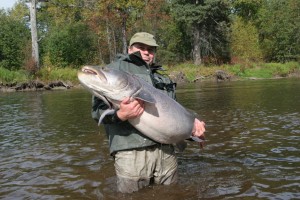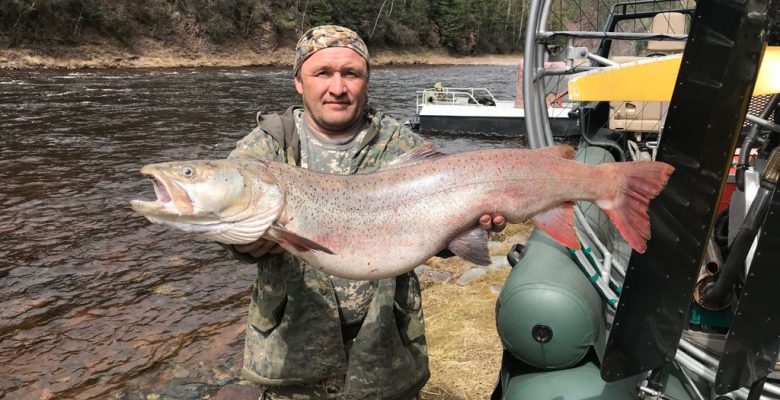Taimen Fishing in Russia

Location: Tuva Republic, Russia
Season dates: August 20 – September 30
Fishing method: Fly fishing, catch and release
Accommodations: Tent camp
Price per person: $4200 group of 5-6; $4700 group of 4; $5500 group of 3
Included in the price:
Reception and assistance in Moscow and Abakan airport; All ground transfers; Meals and soft drinks during the trip; Use of airboats; Services of 1 guide; 1 cook and 1 interpreter; Invitation letter and voucher; Fishing license.
Not included in the price:
Insurance of any kind; International and domestic airfare; Hotel in Moscow if required; Cost of sightseeing tours; Gratuities.
Itinerary:
Day 1: arrival to Moscow, overnight in Petropavlovsk.
Day 2: flight to Abakan village, Tigilsky district, transportation to the hunting cabin
Day 3-9: 7 days of fishing
Day 10: return to Abakan, overnight in Petropavlovsk
Day 11: flight home
Comments:
This taimen trophy expedition takes you to one of the most remote places in Russia. Tuva is a mountainous republic located on the border of Russia and Mongolia. The area is very sparsely populated and has few roads. As the result, it has seen very little fishing pressure and offers outstanding fishing for many species of trout, including Siberian taimen. The tour starts in the town of Abakan with a 360 km (200 mi) drive to a tiny village on the shore of the Yenisey River. The expedition will then board two large airboats for a spectacular ride along Yenisey and Hymsara rivers. Taimen fishing will start on the evening of the first day following the 200 km trip and will continue for the duration of the journey during frequent stops at the mouths of tributaries feeding the Hymsara River, the favorite places for Taimen to feed.
Order Your Trip!!
There is no more prestigious trophy for a fly fisherman than taimen trout. Taimen fishing is difficult and requires traveling to some of the most remote places on earth. Mature taimen is very territorial and is rarely found in proximity to another taimen. Taimen for a good reason is frequently called by the local people water tiger or river wolf. Taimen trout is a tenacious, merciless, swift, and strong predator, who prays not only on fish, but also on birds and small mammals – ducks, snipe, mouse, squirrels, and muskrats. Having excellent sight, it is capable of seeing well in the water, and also distinguishing the objects on the shore. Taimen can jump and snatch small animals on dry land when they are in close proximity to the shoreline. With the autumn temperature drop, Siberian taimen migrates into the deeper, not freezing through parts of the rivers. Taimen lives longer than other Salmonidae, up to 50 years and more, continuously growing during the entire life. Most rapid growth occurs during the first 10-13 years, when its length increases annually by 8-10 centimeters (3-4 inches). Maturity is reached on the 5-7 year of life. Young taimen usually stays in small groups of 3-7, adult – in pairs or as singles. Larger congregations of taimen are observed sometimes prior their migration into the lower streams of the rivers just before winter; during this period very deep holes can have up to 10-15 large specimens. The activity of taimen into the summer-autumn season is subjected to very specific fluctuations. It is most high soon after spawning. During hot weather, when water becomes warm, which happens often in the slower flowing rivers of the South Siberian and Northern Mongolian planes, taimen become sluggish. In the opinion of some fishermen, a drop in their activity at this time is also caused by the painful process of replacing the teeth. Therefore during July and the first half of August catching large taimen in Mongolia and Southern Siberia is rather difficult. Near the end of August taimen becomes more active, and during September in anticipation of ice formation, it becomes very active and even aggressive. In summer the best time to catch taimen is early in the morning and after 5-6 PM, up top the twilight. In autumn biting is more uniform during the day. Taimen can be caught with spinning, using yellow or silver spoon baits between 2 to 4 inches long, or fly rod, using “mouse”. Large taimen, when attacking the “mouse”, may “suppress” it by a violent strike of the tail before turning and taking the bait. In September taimen is not very discriminate in its diet and would take any bait, but during the summer different size and color baits has to be tried.
There are four known species of taimen: Danube taimen (Hucho hucho), Korean taimen (Hucho ischikawai), Sakhalin taimen (Hucho perryi) and the most numerous, Common or Siberian taimen (Hucho taimen).
SAKHALIN TAIMEN (Hucho perryi)
Also called chevitsa is the only species of taimen that migrates to the sea. Sakhalin taimen is found in the Sea of Japan, from where it enters rivers of Hokkaido island, Sakhalin island and Primorsky Krai for spawning in spring and early summer. Sakhalin taimen can reach more than 1 meter in length (40 inches) and 25-30 kg (60-70 lbs) of weight. While at the sea it has a silvery body and in the river body acquires reddish color similar to Siberian taimen. The sides have 5-8 light raspberry-colored transverse strips. Chevitsa usually feeds on small fish. Sergei Shushunov and Russian Hunting LLC offer Sakhalin taimen fishing on the mainland, in Khabarovsk region of Russia.
SIBERIAN TAIMEN (Hucho taimen)
Siberian taimen, also called Common taimen is the most widely distributed and best-known taimen. This is also the most prized taimen trophy. It spawns in spring, right after rivers clear of ice. Siberian taimen can exceed 1.5 meters in length (60 inches) and 100 kilograms in weight (220 lbs). It inhabits rivers with clean water, gravel or stony bottom and large, flowing, cold-water lakes and it never migrates to sea. It frequently stays in the pools and deep holes, under steep shores and in the mouths of tributaries.

The area of distribution is very wide, extending from the Ural mountains to the Pacific Ocean and from the Arctic Ocean to Northern Mongolia and China. Siberian taimen can be caught basically in all Siberian rivers and large lakes: Norilsk, Zaysan, Teletskoye, and Baikal, as well as in some rivers in the north of Mongolia and China. Occasionally Siberian taimen can be caught in some rivers of the European part of Russia. Sergei Shushunov and Russian Hunting LLC offer Siberian taimen trout fishing expeditions to different parts of Russia, including Northern Urals, Siberia, Altai, Tuva, and Yakutia. Current IGFA record of Siberian taimen, caught in 1993 in Keta river of Khabarovsk region of Russia is measured at 42 kg (92 lbs). Unofficial records: Kotui river 105 kg., Amur river 80 kg., Yenisey river 63 kg., Lena river 60 kg.
DANUBE TAIMEN (Hucho hucho)
Also called Danube salmon, is found in the drainages of Danube and Prut rivers. This rare fish can usually reach a weight of 10-12 kg (22-24 lbs). However, the literature described the case of catching specimen weighing 52 kg (115 lbs). Danube taimen feeds on small fish. It usually spawns in April.
We offer Siberian and Pacific taimen trout fishing in different parts of Siberia and Far East of Russia.


